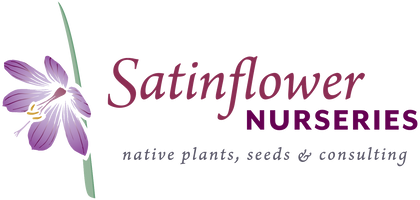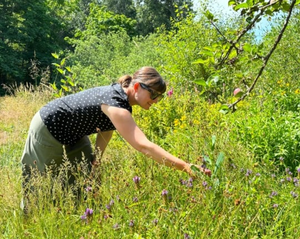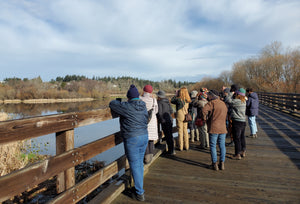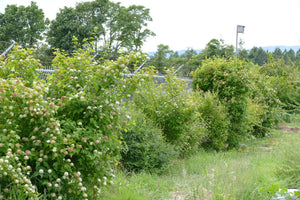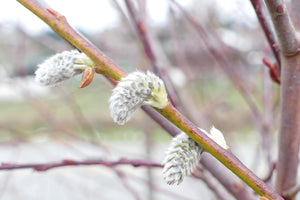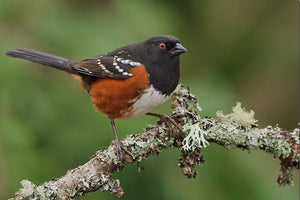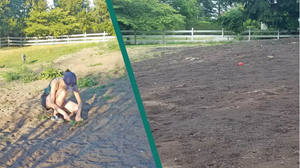The Weekly with Daly: Overwintering Butterflies

The Weekly with Daly is a regular column about the musings of the nursery written by our in-house wildlife observer and passionate conservationist, Julia Daly.
October 4th, 2022
With fall upon us, Vancouver Island butterflies are preparing to hibernate in a variety of fascinating ways. Depending on the species, butterflies may hibernate as adults, pupa (chrysalises), larvae (caterpillars), or eggs. Let’s honour local butterflies by exploring different life history traits between species, and looking at ways we can best support them in all their life cycle phases. Butterfly biology is complex. Throughout this article, you’ll encounter bolded words defined in the glossary.
Currently, 70 species of butterflies are found on Vancouver Island. Of these, 60 are native species that live permanently on Vancouver Island, eight are native migratory species (those which disperse to Vancouver Island after hatching elsewhere in North America), and two are introduced species, the Cabbage White (Pieris rapae) and European Skipper (Thymelicus lineola).
OVERWINTER AS ADULT
Species that hibernate as adults include the Mourning Cloak (Nymphalis antiopa) and Satyr Comma (Polygonia satyrus) (figures 1 and 2). In the early fall, adults seek shelter under fallen leaves, tree bark, woodpiles, or other crevices to ride out cold winter temperatures. Overwintering adults emerge in the early spring and persist on tree sap, mud, and dung until more nectar plants are available. The Mourning Cloak and Satyr Comma are some of the earliest spring butterflies reported on Vancouver Island and have occasionally been seen in December or January in unusually warm weather.
Mourning Cloaks lay their eggs in cylindrical clusters around Willows, Trembling Aspen and Black Cottonwood twigs in the early spring. After the eggs hatch, the maturing larvae feed on tree leaves until they pupate. This next generation of adults emerge and fly in June and July, then aestivate through August, and briefly reemerge in September to feed on tree sap before finding shelter and hibernating for the winter.
While most butterflies in BC are univoltine (have only one brood per year), the Satyr Comma is bivoltine and capable of two per year. After hibernation, this species seeks out its host plant, Stinging Nettle (Urtica dioica), to lay its eggs. After the eggs hatch, the caterpillars feast on nettle leaves until they pupate. Adults emerge in June. This generation lays more eggs, which eclose in July and August. These adults will hibernate over winter before mating and seeking stinging nettle to lay eggs the following spring.

Figure 1 (left). Mourning Cloak, April 3, 2013, emerging after hibernating for the winter as an adult.
Figure 2 (right). Satyr Comma basking on its host plant, Stinging Nettle. June 15, 2003.
OVERWINTER AS PUPAE
Butterflies that hibernate as pupae (chrysalises) include the Julia’s Orangetip (Anthocharis julia flora) (figure 3) and Anise Swallowtail (Papilio zelicaon) (figure 4).
Julia’s Orangetips prefer to lay eggs on members of the mustard family (Brassicaceae). After the eggs hatch, larvae feed on the leaves and flowers of their host plants before pupating and hibernating over the winter. Adults emerge and fly from mid-March through May, later in higher elevations. Tower Mustard (Turritis glabra) and American wintercress (Barbarea orthoceras) are good choices of native mustards for this species (J. Miskelly, personal communication, October 1st, 2022).
Anise Swallowtails use members of the Carrot family (Apiaceae) as larval foodplants. In lowland areas where host plants like Lomatium nudicaule and Heracleum maximum grow abundantly, adults may fly from April to September. Their flight season may be much shorter in dryer hilltop areas where host plants senesce earlier in the season. Adults lay their eggs singly on host plants. After hatching, caterpillars feast on the leaves and flowers, pupate on the stems and emerge as adults the following spring.

Figure 3 (left). Female Julia’s Orangetip, Mount Cokley, June 30, 2013. Like many butterfly species, Julia’s Orangetips exhibit sexual dimorphism, meaning that males and females have different patterning.
Figure 4 (right). Anise swallowtail larva (5th instar), Kissinger Lake, feeding on Kneeling Angelica (Angelica genuflexa), August 28, 2022.
OVERWINTER AS LARVAE
The Propertius Duskywing (Erynnis propertius) (figure 5) and Woodland Skipper (Ochlodes sylvanoides) (figures 6 and 7) are examples of butterflies that hibernate as larvae.
The Propertius Duskywing is Red-listed in BC and at risk of extirpation. The decline of this species is correlated with the loss and degradation of Garry oak meadow and woodland habitat on Vancouver Island and the Gulf Islands. Its larval foodplant, Garry oak (Quercus garryana), is vital to its survival. Females lay their eggs in the Garry oaks in the spring. After the eggs hatch, the larva feeds on the oak leaves until they reach the 5th instar. The mature caterpillars attach themselves to the leaves in silk chambers and fall to the ground when the leaves drop from the trees. The larvae hibernate on the ground in the leafy debris. In the spring, the larvae continue to develop and pupate amongst the leaves. Adult Propertius Duskywings emerge in April and fly through June.
The Woodland Skipper is in the Subfamily Hesperiinae (Grass Skippers), all of which use grasses or sedges as their larval food plants. This species flies in open, grassy habitats from late July through mid-fall. Females lay eggs on the underside of dry grass leaves in August and September, preferring tall grass species like Blue wildrye (Elymus glaucus) and California Brome (Bromus carinatus). After the eggs hatch, the first instar builds an overwintering shelter by fastening the edges of the grass leaf blade together with silk. The young caterpillars enter hibernation without feeding. Larvae continue to develop into the late spring when they will begin leaving their grass shelters at night to feed on tender spring grasses and return to the safety of their hiding place during the day.

Figure 5 (left). Adult Propertius Duskywing. June 2, 2013.
Figure 6 (right). Woodland Skipper nectaring on Pearly Everlasting (Anaphalis margaritacea) August 7, 2021
OVERWINTER AS EGGS
Pine Whites (Neophasia menapia) overwinter as eggs. In late summer, Females lay eggs stuck together in a row at the base of conifer needles in the Pine family (Pinaceae), including Douglas-fir, Lodgepole pine, and Western Hemlock, where they overwinter. After hatching in the spring, the larvae feed on tender new conifer needles. Pine Whites may pupate on tree branches, or the larva may drop to the ground on silk threads and pupate at the tree base.

Figure 7 (left) Woodland skipper larva, 3rd or 4th instar. June 15, 2005.
Figure 8 (right). Pine White basking on river rock on the Chemainus River August 24, 2022.
The loss and fragmentation of Garry oak meadows, woodlands and open Doulas-fir forest habitats traditionally managed by First Peoples have had a tremendous impact on Vancouver Island Butterflies. Over the past 100 years, butterfly populations on Southern Vancouver Island have declined sharply, and several species are no longer found here. Eighteen local species are listed as species at risk. To prevent further declines, we must better understand the needs of butterflies, conserve what remains of their habitat, and restore historic plant assemblages and traditional fire management to these areas. While most butterflies nectar on many plant species, they will often only lay their eggs on a single or select few host plants. Therefore, providing both nectar plants and species-specific host plants is critical in supporting butterflies in all their lifecycle phases.
Tips for Supporting Overwintering Butterflies
- Familiarize yourself with the larval host plants of different butterfly species. Protect and plant more of these plants and trees: https://cdn.shopify.com/s/files/1/0435/5306/3061/files/SNP_handout_Butterflies_March_2020_2.pdf?v=1618507189)
- Ensure fallen leaves remain undisturbed over the fall and winter (don’t rake them away!) There could be butterfly eggs and caterpillars amongst them
- Think twice about cutting back or pruning vegetation as there may be eggs or pupae attached to the foliage
- Conserve standing dead wood and woody debris piles
- Join efforts to conserve and restore native vegetation to seasonally dry meadows, open forests, and rocky slope habitats that are favourable to butterflies
GLOSSARY
Aestivate: Spend a hot, dry period in a prolonged state of torpor
Chrysalis: Where larva develops protective case in the final stage of development into an adult
Diapause: Period of suspended development, especially during periods of unfavourable environmental conditions
Eclose: When an adult butterfly emerges from the pupa
Host plant: Preferred larval foodplant of a butterfly
Instar: Stage of caterpillar growth between moults. Most caterpillars moult several times before forming chrysalises. Each time the caterpillar moults, it advances to the next instar (1st, 2nd, 3rd, 4th and 5th instar).
Species at risk: A plant or animal considered in danger of disappearing from the wild. In Canada, assessments are made at Federal and Provincial government levels and classified based on the level of risk.
Voltinism: The frequency or number of annual broods of an insect
- Tags: Weekly with Daly
- Satinflower Nurseries
